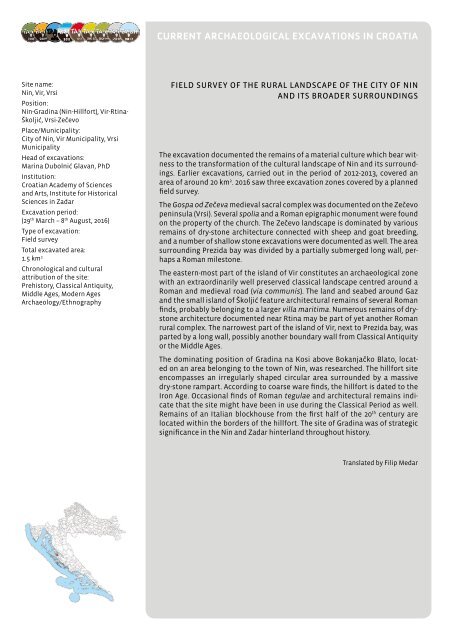AMZ_TAIUH_2017_ prijevodi na engleski
You also want an ePaper? Increase the reach of your titles
YUMPU automatically turns print PDFs into web optimized ePapers that Google loves.
CURRENT ARCHAEOLOGICAL EXCAVATIONS IN CROATIA<br />
Site <strong>na</strong>me:<br />
Nin, Vir, Vrsi<br />
Position:<br />
Nin-Gradi<strong>na</strong> (Nin-Hillfort), Vir-Rti<strong>na</strong>-<br />
Školjić, Vrsi-Zečevo<br />
Place/Municipality:<br />
City of Nin, Vir Municipality, Vrsi<br />
Municipality<br />
Head of excavations:<br />
Mari<strong>na</strong> Dubolnić Glavan, PhD<br />
Institution:<br />
Croatian Academy of Sciences<br />
and Arts, Institute for Historical<br />
Sciences in Zadar<br />
Excavation period:<br />
(29 th March – 8 th August, 2016)<br />
Type of excavation:<br />
Field survey<br />
Total excavated area:<br />
1.5 km 2<br />
Chronological and cultural<br />
attribution of the site:<br />
Prehistory, Classical Antiquity,<br />
Middle Ages, Modern Ages<br />
Archaeology/Ethnography<br />
FIELD SURVEY OF THE RURAL LANDSCAPE OF THE CITY OF NIN<br />
AND ITS BROADER SURROUNDINGS<br />
The excavation documented the remains of a material culture which bear witness<br />
to the transformation of the cultural landscape of Nin and its surroundings.<br />
Earlier excavations, carried out in the period of 2012-2013, covered an<br />
area of around 20 km 2 . 2016 saw three excavation zones covered by a planned<br />
field survey.<br />
The Gospa od Zečeva medieval sacral complex was documented on the Zečevo<br />
peninsula (Vrsi). Several spolia and a Roman epigraphic monument were found<br />
on the property of the church. The Zečevo landscape is domi<strong>na</strong>ted by various<br />
remains of dry-stone architecture connected with sheep and goat breeding,<br />
and a number of shallow stone excavations were documented as well. The area<br />
surrounding Prezida bay was divided by a partially submerged long wall, perhaps<br />
a Roman milestone.<br />
The eastern-most part of the island of Vir constitutes an archaeological zone<br />
with an extraordi<strong>na</strong>rily well preserved classical landscape centred around a<br />
Roman and medieval road (via communis). The land and seabed around Gaz<br />
and the small island of Školjić feature architectural remains of several Roman<br />
finds, probably belonging to a larger villa maritima. Numerous remains of drystone<br />
architecture documented near Rti<strong>na</strong> may be part of yet another Roman<br />
rural complex. The <strong>na</strong>rrowest part of the island of Vir, next to Prezida bay, was<br />
parted by a long wall, possibly another boundary wall from Classical Antiquity<br />
or the Middle Ages.<br />
The domi<strong>na</strong>ting position of Gradi<strong>na</strong> <strong>na</strong> Kosi above Bokanjačko Blato, located<br />
on an area belonging to the town of Nin, was researched. The hillfort site<br />
encompasses an irregularly shaped circular area surrounded by a massive<br />
dry-stone rampart. According to coarse ware finds, the hillfort is dated to the<br />
Iron Age. Occasio<strong>na</strong>l finds of Roman tegulae and architectural remains indicate<br />
that the site might have been in use during the Classical Period as well.<br />
Remains of an Italian blockhouse from the first half of the 20 th century are<br />
located within the borders of the hillfort. The site of Gradi<strong>na</strong> was of strategic<br />
significance in the Nin and Zadar hinterland throughout history.<br />
Translated by Filip Medar


